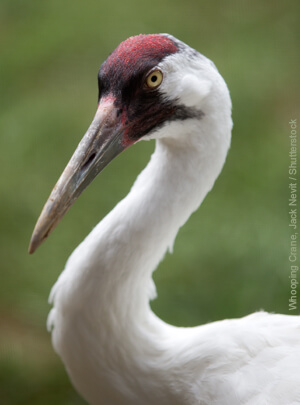Major Bird Conservation Groups Oppose Merricourt Wind Energy Project in North Dakota
 |
| The endangered Whooping Crane is one of the many species at risk from wind energy development in sensitive habitats. |
(Washington, D.C., November 21, 2014) Two leading bird conservation groups, American Bird Conservancy and the International Crane Foundation, have sent a joint letter to the U.S. Fish and Wildlife Service (FWS) voicing strong concerns about renewed consideration of the Merricourt wind energy project in North Dakota.
The November 17 letter from the groups identified concerns about the wind development that would straddle southeastern North Dakota's McIntosh and Dickey counties. It was sent to Noreen Walsh, Director of the FWS Mountain-Prairie Region.
The Merricourt project, proposed by EDF Renewable Energy, was thought to have been aborted when another company, Xcel, terminated a contract to buy the energy generated by the turbines after EDF failed to secure a site permit from state regulators in 2011. However, EDF has since modified its application and reduced the number of proposed turbines from approximately 100 to about 75 and reduced the apparent amount of land impacted from 22,457 acres to 10,960 acres. The turbines would stand about 425 feet tall. The North Dakota Public Service Commission has scheduled a public hearing on the proposal for December 22.
According to the ABC/ICF letter, the project would “… be located in a key migratory pathway for many federally-protected birds in the Prairie Pothole region of North Dakota, including the federally-listed Whooping Crane and Piping Plover. The loss of even a few Whooping Cranes could result in a population-level effect, so the bar for approval of this project must be set very high. With such serious Endangered Species Act concerns, we would hope that a(n) … Environmental Impact Statement (EIS) would be required before the Service would even consider issuing the first incidental take permit for Whooping Cranes.”
Under FWS' current voluntary permitting guidelines for wind energy development, companies are not required to apply for permits authorizing the killing or impacting of wildlife when a project such as Merricourt sits on private property. However, ABC and ICF assert that this does not allow developers to break the law and kill federally-protected wildlife with impunity. The groups ask that post-construction bird deaths be monitored independently (by a third party) to accurately assess wildlife mortality.
The letter continues: “How will the FWS assess and take into account the cumulative impact of nearly a hundred large, commercial turbines, including disturbance on Whooping Cranes, especially considering that 5,500 turbines already exist in the species' migratory corridor and that 18,518 are planned. … We are also concerned that Whooping Cranes may be impacted by the considerable habitat disturbance that will result from this and other energy development projects in the migratory corridor.”
In addition, many new transmission lines and towers—the most significant threat to Whooping Cranes posed by the wind installation—will also be installed to carry the electrical energy produced by these turbines into the grid.
While a host of bird and bat mortality mitigation techniques are touted by the industry, the bird conservation groups point out that few have actually been tested for effectiveness. Those techniques include the use of radar to detect birds, combined with temporary or seasonal shutdowns such as during migration; lighting adjustments to reduce attraction; habitat management, including removal of standing water and vegetation under turbines; prey population management to make the habitat less attractive to raptors; and retrofitting associated transmission lines and towers to reduce the risk of collisions and electrocution. ABC and ICF call for testing of these techniques under a variety of circumstances that take into account variables such as seasons, time of day, landscapes, and weather conditions.
“All of these factors can influence the risk of wind energy development to federally-protected birds, such as the highly-endangered Whooping Crane, upon which tens of millions of tax dollars have been spent on recovery,” says the letter. The letter is signed by Dr. Michael Hutchins, Bird Smart Wind Energy Campaign Coordinator for ABC, and Dr. Julia A. Langenberg, Vice-President of Conservation for ICF.
ABC and ICF support the development of clean, renewable sources of energy such as wind and solar power, but also believe that it must be done responsibly and with minimal impact on our public trust resources, including native species of birds and bats, and particularly threatened, endangered, and other protected species, such as Bald and Golden Eagles. ABC and ICF support Bird Smart Wind Energy, which is described in detail on the ABC website.


















































